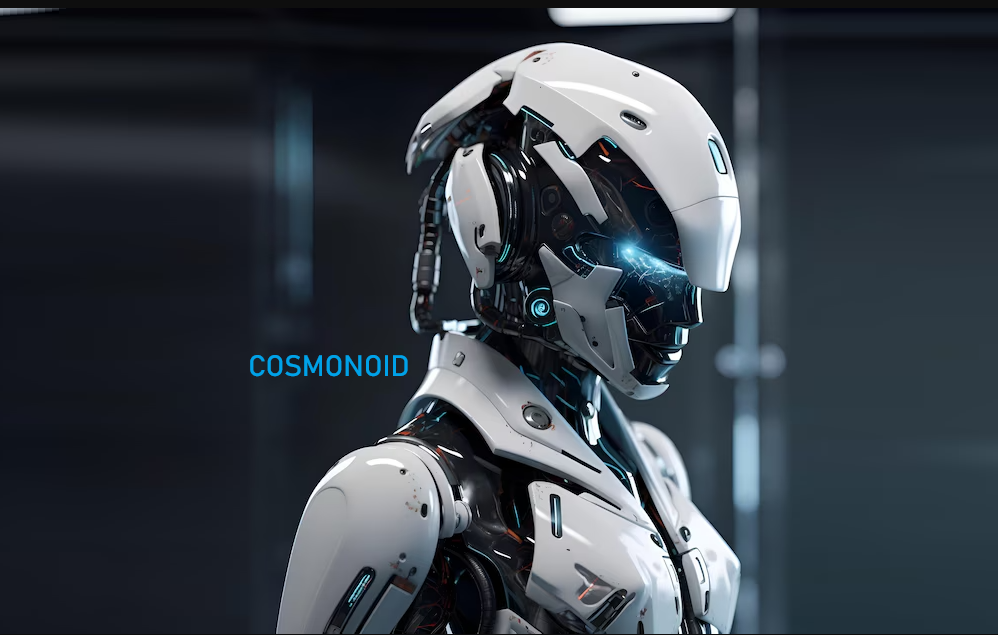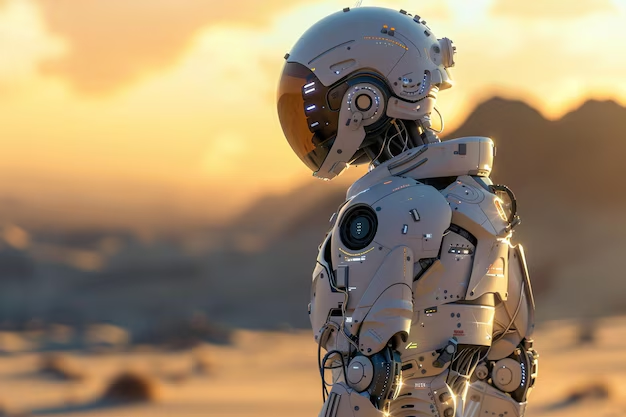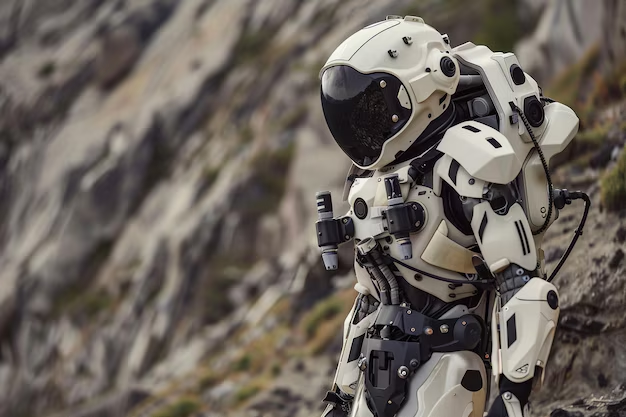
Cosmonoid Humanoids: Pioneering the Future of Space Exploration and Settlement
August 9, 2024
The Case for Cosmonoid Humanoids in Space Exploration: A Technological and Ethical Imperative
The grand endeavor of space exploration and colonization has captivated human imagination for centuries. As we stand on the precipice of venturing beyond Earth's confines, the question of how to establish sustainable human settlements on other planets looms large. While the dream of sending humans to Mars and beyond remains tantalizing, the harsh realities of space travel and the limitations of current technology necessitate a paradigm shift in our approach.
In this context, the concept of Cosmonoid humanoids emerges as a compelling and potentially transformative solution. These advanced robotic systems, designed to mimic human form and function, offer a unique opportunity to mitigate the risks associated with human spaceflight while accelerating the progress toward extraterrestrial colonization.
The Technological Imperative
The challenges of sending humans to Mars are manifold. The journey itself poses significant risks due to radiation exposure, microgravity-induced health issues, and the psychological toll of isolation. Furthermore, establishing a self-sustaining colony on a barren planet with extreme temperatures, limited resources, and a hostile environment requires unprecedented technological prowess.
Cosmonoid humanoids offer a way to circumvent these challenges. By sending robotic pioneers ahead of human settlers, we can:
- Mitigate Risks: Robots are immune to the biological hazards of space travel and can operate in extreme environments without life support systems, reducing the immediate dangers to human life.
- Accelerate Progress: Robots can work tirelessly and efficiently, 24/7, to construct habitats, gather resources, and conduct experiments, paving the way for human arrival.
- Test Technologies: Cosmonoids can serve as testbeds for new technologies, such as closed-loop life support systems, in-situ resource utilization, and advanced robotics, ensuring their reliability before humans arrive.
The Ethical Imperative
As some current proposals suggest, sending humans on a one-way journey to Mars raises profound ethical concerns. The risk of failure is high, and the potential for loss of life is a heavy burden to bear. Furthermore, the long-term consequences of isolating a small group of humans on a distant planet are unknown.
Cosmonoid humanoids offer a more ethical alternative. By sending robots first, we prioritize the safety and well-being of human explorers while still advancing the cause of space colonization. This approach aligns with the principles of responsible innovation and ensures we prioritize human life above all else.
The State of the Art in Humanoid Robotics: Building the Cosmonoid Blueprint

The vision of Cosmonoid humanoids might seem like science fiction, but the reality is that significant advancements in humanoid robotics have already been made. While fully autonomous and versatile humanoid robots for space exploration are still under development, several key technologies are converging to make this vision a tangible possibility.
Locomotion and Manipulation:
Bipedal locomotion, the ability to walk on two legs like humans, is a fundamental requirement for Cosmonoids to navigate complex terrains and perform tasks in human-designed environments. Boston Dynamics' Atlas robot is a prime example of progress in this area, showcasing impressive agility, balance, and even parkour skills.
Dexterous manipulation, the ability to grasp and manipulate objects with precision, is another crucial capability. Shadow Robot Company's Dexterous Hand, with its human-like fingers and tactile sensors, demonstrates the potential for robots to handle delicate tasks and operate tools designed for humans.
Artificial Intelligence and Autonomy:
To function effectively in the unpredictable and dynamic environment of Mars, Cosmonoids will need advanced artificial intelligence (AI) capabilities. This includes perception, decision-making, learning, and adaptation. OpenAI's GPT-4 language model showcases the potential for AI to understand and generate human-like language, which could be crucial for communication and collaboration between humans and Cosmonoids.
Resilience and Self-Repair:
Given the vast distance and communication delays between Earth and Mars, Cosmonoids will need to be highly resilient and capable of self-repair. NASA's Robonaut 2, designed for maintenance tasks on the International Space Station, demonstrates the potential for robots to perform repairs and replace components autonomously.
Challenges and Opportunities:
While these advancements are promising, significant challenges remain. Creating humanoid robots that can operate reliably and autonomously in the harsh conditions of Mars requires further research and development in areas such as power management, thermal regulation, and radiation shielding.
However, the potential rewards of developing Cosmonoid humanoids are immense. Not only could they pave the way for safer and more efficient space exploration, but they could also revolutionize industries on Earth, from healthcare and disaster response to manufacturing and construction.
Cosmonoid Design and Function: A Blueprint for Martian Pioneers
The design and functionality of Cosmonoid humanoids are critical to their success in establishing a foothold on Mars. Drawing inspiration from human physiology while incorporating cutting-edge robotic technologies, Cosmonoids would be engineered to withstand the harsh Martian environment and perform a wide array of tasks essential for colonization.
Physical Form and Locomotion:
While the humanoid form offers advantages in terms of dexterity and adaptability, it also presents challenges in terms of energy efficiency and stability on uneven terrain. To address this, a hybrid approach is proposed, where Cosmonoids would possess a modular design with interchangeable locomotion systems.
- Bipedal Mode: For navigating complex terrains and performing tasks that require human-like dexterity, Cosmonoids would utilize bipedal locomotion, advanced balance algorithms, and adaptive gait patterns.
- Wheeled Mode: For efficient travel over long distances and flat terrains, Cosmonoids could switch to a wheeled mode, conserving energy and maximizing range.
- Other Modes: Additional locomotion modes, such as crawling or climbing, could be incorporated to further enhance their versatility.
Sensing and Perception:
To interact effectively with their environment, Cosmonoids would be equipped with a suite of advanced sensors:
- Visual Sensors: High-resolution cameras and lidar systems would provide detailed 3D maps of the surroundings, enabling navigation and object recognition.
- Tactile Sensors: Pressure-sensitive skin and force sensors would allow Cosmonoids to interact with objects delicately and safely.
- Environmental Sensors: Temperature, radiation, and atmospheric sensors would monitor the Martian environment, ensuring the robots' safety and providing valuable data for scientific research.
Manipulation and Tool Use:
Cosmonoids possess dexterous hands with multiple fingers, capable of operating a wide range of tools designed for humans. This would enable them to perform tasks such as:
- Construction: Assembling habitats, infrastructure, and equipment using prefabricated components or local materials.
- Resource Extraction: Mining ice for water, extracting metals from the soil, and harvesting energy from solar panels.
- Maintenance and Repair: Conducting routine maintenance and repairs on equipment and infrastructure, ensuring the long-term sustainability of the settlement.
Artificial Intelligence and Autonomy:
The most critical aspect of Cosmonoid design is their artificial intelligence (AI). To operate effectively in the dynamic and unpredictable Martian environment, Cosmonoids would need to be capable of:
- Autonomous Decision-Making: Analyzing sensor data, assessing situations, and making decisions based on pre-programmed goals and priorities.
- Learning and Adaptation: Continuously learning from their experiences, improving their performance over time, and adapting to new challenges.
- Communication and Collaboration: Communicating with each other and with human operators on Earth, sharing information, and coordinating tasks.
Ethical Considerations and Societal Implications: Shaping the Future of Human-Robot Collaboration in Space
The development and deployment of Cosmonoid humanoids raise profound ethical and societal questions that must be carefully considered. As we venture into the realm of autonomous robots capable of performing complex tasks in remote environments, we must grapple with issues of responsibility, accountability, and the potential impact on human society.
Ethical Considerations:
- Autonomy and Decision-Making: To what extent should Cosmonoids be granted autonomy in making decisions that could impact human life or the Martian environment? How can we ensure that their actions align with human values and ethical principles?
- Responsibility and Accountability: Who is responsible for the actions of Cosmonoids? If a robot malfunctions and causes harm, who is liable? How can we ensure transparency and accountability in the development and deployment of these systems?
- Human-Robot Interaction: How will humans interact with Cosmonoids? Will they be seen as tools, partners, or something else entirely? What are the potential psychological and social implications of working alongside robots in isolated environments?
Societal Implications:
- Economic Impact: The development and deployment of Cosmonoids could create new industries and jobs, but could also lead to job displacement in certain sectors. How can we ensure a just transition and equitable distribution of benefits?
- Environmental Impact: The activities of Cosmonoids on Mars could have unintended consequences for the planet's fragile ecosystem. How can we minimize our impact and ensure that we act as responsible stewards of another world?
- Existential Questions: The development of advanced humanoid robots raises fundamental questions about what it means to be human. What are the boundaries between humans and machines? What role will robots play in our future society?
Towards Responsible Innovation:
To address these ethical and societal concerns, a multidisciplinary approach is needed. Ethicists, philosophers, social scientists, policymakers, and the public must engage in open and transparent dialogue to establish guidelines and regulations for the development and deployment of Cosmonoid humanoids.
We must prioritize transparency, accountability, and human oversight in the design and operation of these systems. We must also invest in research to understand the potential social and psychological impacts of human-robot interaction in space.
By embracing a responsible approach to innovation, we can ensure that Cosmonoid humanoids serve as a force for good, advancing our understanding of the universe and paving the way for a sustainable human presence beyond Earth.
Conclusion: Cosmonoid Humanoids - A Bold Vision for the Future of Space Exploration

The quest to explore and colonize space represents one of humanity's most ambitious endeavors. As we stand on the threshold of a new era of space exploration, the concept of Cosmonoid humanoids emerges as a beacon of hope, offering a path to overcome the challenges and risks inherent in this grand endeavor.
Cosmonoid humanoids, with their unique blend of human-like form and advanced robotic capabilities, have the potential to revolutionize the way we approach space exploration and colonization. By sending these robotic pioneers ahead of human settlers, we can mitigate risks, accelerate progress, and pave the way for a sustainable human presence on other planets.
While the development and deployment of Cosmonoids present significant technical, ethical, and societal challenges, the potential rewards are immense. These humanoid robots could not only unlock the secrets of the universe but also transform industries on Earth, leading to discoveries, technologies, and economic opportunities.
To realize this bold vision, we must embrace a collaborative and multidisciplinary approach, bringing together scientists, engineers, ethicists, policymakers, and the public. We must prioritize responsible innovation, ensuring that Cosmonoid humanoids are developed and deployed in a manner that benefits all of humanity.
As we look to the future, the Cosmonoid concept serves as a reminder of our boundless potential as a species. By harnessing the power of human ingenuity and technological innovation, we can overcome the challenges of space exploration and create a future where humans and robots work together to explore the cosmos and expand our horizons beyond Earth. The journey to Mars and beyond may be long and arduous, but with Cosmonoid humanoids by our side, we are one step closer to achieving our destiny among the stars.
References:
- Boston Dynamics. (n.d.). Atlas. https://www.bostondynamics.com/atlas
- OpenAI. (2023). GPT-4 Technical Report. https://cdn.openai.com/papers/gpt-4.pdf
- Shadow Robot Company. (n.d.). The Dexterous Hand. https://www.shadowrobot.com/dexterous-hand/
- NASA. (n.d.). Robonaut 2. https://robonaut.jsc.nasa.gov/